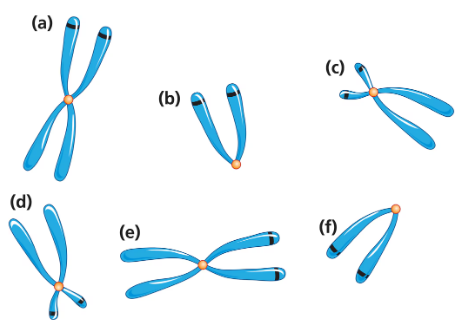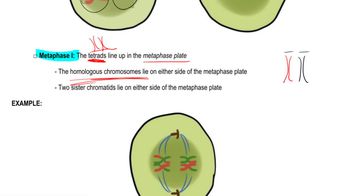Table of contents
- 1. Introduction to Genetics51m
- 2. Mendel's Laws of Inheritance3h 37m
- 3. Extensions to Mendelian Inheritance2h 41m
- 4. Genetic Mapping and Linkage2h 28m
- 5. Genetics of Bacteria and Viruses1h 21m
- 6. Chromosomal Variation1h 48m
- 7. DNA and Chromosome Structure56m
- 8. DNA Replication1h 10m
- 9. Mitosis and Meiosis1h 34m
- 10. Transcription1h 0m
- 11. Translation58m
- 12. Gene Regulation in Prokaryotes1h 19m
- 13. Gene Regulation in Eukaryotes44m
- 14. Genetic Control of Development44m
- 15. Genomes and Genomics1h 50m
- 16. Transposable Elements47m
- 17. Mutation, Repair, and Recombination1h 6m
- 18. Molecular Genetic Tools19m
- 19. Cancer Genetics29m
- 20. Quantitative Genetics1h 26m
- 21. Population Genetics50m
- 22. Evolutionary Genetics29m
9. Mitosis and Meiosis
Mitosis
Problem 29b
Textbook Question
A eukaryote with a diploid number of 2n=6 carries the chromosomes shown below and labeled (a) to (f).

Explain how you determined the correct alignment of homologous chromosomes on opposite sides of the metaphase plate.
 Verified step by step guidance
Verified step by step guidance1
Understand the diploid number (2n=6), which indicates there are 6 chromosomes in total, organized into 3 homologous pairs. Each homologous pair consists of one chromosome inherited from each parent.
Identify homologous chromosomes by matching them based on size, centromere position, and banding patterns. For example, chromosomes labeled (a) and (b) might form one homologous pair, (c) and (d) another, and (e) and (f) the third pair.
Recall that during metaphase of mitosis, homologous chromosomes align along the metaphase plate. Each chromosome in a homologous pair is positioned on opposite sides of the plate, ensuring proper segregation during anaphase.
Consider the role of spindle fibers and kinetochores. Spindle fibers attach to the kinetochores of each chromosome, pulling them toward opposite poles. This ensures that homologous chromosomes are correctly aligned and segregated.
Verify the alignment by ensuring that each homologous pair is positioned symmetrically on opposite sides of the metaphase plate, with no mismatches or errors in pairing. This step is crucial for maintaining genetic integrity during cell division.
 Verified video answer for a similar problem:
Verified video answer for a similar problem:This video solution was recommended by our tutors as helpful for the problem above
Video duration:
2mPlay a video:
Was this helpful?
Key Concepts
Here are the essential concepts you must grasp in order to answer the question correctly.
Homologous Chromosomes
Homologous chromosomes are pairs of chromosomes in a diploid organism that have the same structure and gene sequence but may carry different alleles. Each parent contributes one chromosome to the pair, and during meiosis, these chromosomes align at the metaphase plate. Understanding their alignment is crucial for ensuring proper segregation during cell division.
Recommended video:
Guided course

Chromosome Structure
Metaphase Plate
The metaphase plate is an imaginary plane that is equidistant from the two spindle poles during metaphase of cell division. It is where chromosomes align before being separated into daughter cells. Proper alignment on the metaphase plate is essential for accurate chromosome distribution, preventing aneuploidy.
Recommended video:
Guided course

Meiosis Steps
Chromosome Pairing and Alignment
During metaphase, homologous chromosomes pair up and align along the metaphase plate, with one chromosome of each pair facing each spindle pole. This alignment is facilitated by the spindle apparatus, which ensures that each daughter cell receives one chromosome from each homologous pair. Correct pairing is vital for genetic stability and diversity.
Recommended video:
Guided course

Chromosome Structure
Related Videos
Related Practice
Textbook Question
You are given a metaphase chromosome preparation (a slide) from an unknown organism that contains 12 chromosomes. Two that are clearly smaller than the rest appear identical in length and centromere placement. Describe all that you can about these chromosomes.
725
views


